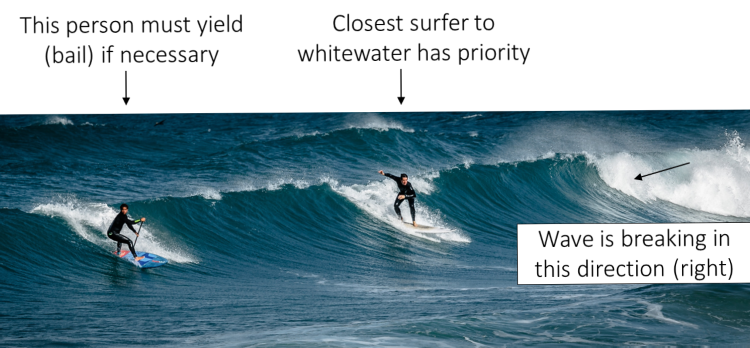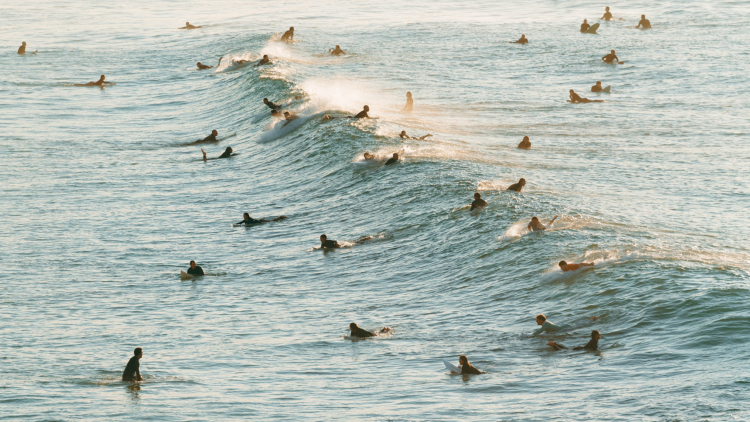Surf etiquette is an established system of rules that all surfers should follow at all times, regardless of skill level or location. Beginner surfers must learn and follow surf etiquette when they are able to paddle out to the break.
Adherence to surf etiquette is critical to ensure the safety of all surfers in the water. Continue reading this beginner’s guide to learn everything you need to know about surf etiquette!
Why is surf etiquette important?
Surf etiquette exists primarily because it keeps surfers safe. Safety in the water is the most important thing in surfing. It is especially important to follow surf etiquette on crowded days, where the risk of collision is higher. Learn more about how to stay safe while surfing.
In addition to safety, surf etiquette helps all surfers have a fair chance at catching waves. Also, it ensures that surfers have plenty of space on the face of the wave to enjoy the ride, without having to dodge other surfers.
How to approach surf etiquette as a beginner
As a beginner, surf etiquette may seem intimidating. After all, you don’t want to mess up and hurt yourself or someone else. At first it can be complicated, but once you get more experience, surf etiquette becomes a habit.
Beginner surfers should approach surf etiquette as an essential set of rules to follow in the water. However, recognize that you will mess up once or twice. Making mistakes is part of the learning process! Just do your best to learn from them.
When to follow surf etiquette
Surf etiquette should be followed at all times in the water, but can be broken into three categories:
- During the paddle out to the break
- Waiting for a wave in the lineup
- Catching a wave
Let’s go through each of these categories in detail in the following sections.
Surf etiquette while paddling out to the break
During the paddle out to the break, it is the paddler’s responsibility to ensure they avoid people surfing waves. Be sure to give the surfer access to the entire face of the wave. Dodging paddlers is annoying when you are surfing a wave.
How to avoid surfers when paddling out

The main idea is to avoid the surfers. There are two options: paddle far outside, or paddle inside into the white water. Doing a duck dive or turtle roll into the whitewater is often necessary to avoid a surfer, even if it may be inconvenient.
For many reef and point breaks, the waves generally break from one side to the other, and there is often a clear lane to paddle out. If there is not a clear spot to paddle out, as is often the case with many beach breaks, just use your best judgement.
Don’t let go of your surfboard
No matter what, don’t let go of your surfboard, even if you are using a leash (which you always should be). An out-of-control surfboard is dangerous to other surfers. The only exception to this is when you are certain there are no surfers near you, and you need to ditch your board and dive under a big wave.
Surf etiquette in the lineup
Once you make it to the break, there may or may not be an established lineup. Sometimes, the lineup is clearly defined (often with a reef or point break) but sometimes there is no clear lineup (often with beach breaks).
Regardless of how defined or crowded the lineup is, try to wait your turn and give everyone a fair shot. More often than not this is just done by feel. Don’t be the person who tries to go for every good wave that comes in. Give others a chance as well.
In addition, give other surfers space in the lineup. Don’t sit right behind someone or too close to them. That could inhibit both you and them when a wave comes in.
How to make sure you share waves
The lineup is often imperfect so it can be hard to accurately “take turns”. Just try your best to keep track of how many waves you catch in comparison to other surfers. Change your effort to catch waves based on how many surfers are in the water. This is a learned skill that will improve over time.
One way to ensure you are not hogging waves is to not catch consecutive waves. If you try and miss a wave, let some go for others before trying again. If you catch a wave and paddle back out to the lineup, let a few go by for others. Sharing is caring!
Surf etiquette when catching a wave
The most important part of surf etiquette comes into play when more than one person can catch a wave. When more than one person is trying to catch the same wave, the following rules apply:
- The surfer who is most inside (closest to where the wave is breaking) has priority
- The surfer who clearly catches the wave first has priority
- Surfers who do not have priority must yield

It is called dropping in if a surfer on the outside catches the wave even if there is a surfer on the inside. This is against surf etiquette and definitely not something you should do.
How to avoid dropping in on other surfers
To avoid dropping in, keep your head up when you paddle into a wave. Look left and right to see what the wave is doing and observe other surfers. It is okay to go for a wave at the same time as other surfers as long as the correct surfer yields when the other catches the wave.
How to yield the wave to a surfer with priority
If there is a surfer on the same wave as you and you must yield, you want to do so efficiently and safely. To yield, sit back on your board and put your feet down to slow your momentum. Make sure you hold onto your board no matter what so that you avoid hitting anyone around you.

More surf etiquette concepts to know
We’ve discussed the three main categories of surf etiquette in the water. These are really the main principles of surf etiquette. However, there are some other general concepts to be aware of.
Respect local surfers when traveling
First, respect local surfers. If you are traveling to surf, especially internationally, make sure you give local surfers more priority than you would if you were at your own local spot. It is best not to step on anyone’s toes. Some surfers can get particular about
Surf within your abilities
Don’t surf outside of your limits. Understand your skill level and only surf at surf spots and during conditions that are suitable for you. If you are not experienced enough to manage large waves or sketchy entry/exits, then you are putting yourself and others at risk. Learn more about how to choose a beginner-friendly surf spot.
Always use a leash
A leash is essential to preventing your board from hitting other surfers. Surfboards, especially longboards, are heavy and can hurt people severely upon collision. A leash is the best way to prevent a runaway surfboard. Also, don’t ever let go of your surfboard unless you know for certain no other surfers are nearby.
Give beginner surfers a break
Intermediate and advanced surfers should go easy on beginners. It is hard to learn surf etiquette and usually involves making mistakes. Beginners will make mistakes when learning surf etiquette. If you are a beginner, make sure you learn from your mistakes. Ask someone if you don’t understand what you did wrong.
Stay positive and have fun!
As in life, surfing doesn’t always go your way. When you feel frustrated, defeated, or upset, remember that surfing should be challenging but fun. Keep a positive attitude and enjoy the ups and downs of the surfing experience.
Conclusion
Learning and following surf etiquette is critical to avoid injuries and conflicts in the water. Surf etiquette may seem intimidating at first, but with experience it becomes habit. Don’t be afraid to ask other surfers questions, especially if you think you may be at fault. Good luck!
Heads up! Surfing is awesome but it can be dangerous! Learn more about how to stay safe and avoid dangers while surfing. If you are a beginner surfer, check out my other articles about surfing and my ultimate guide to learning how to surf.


![Best longboard surfboards [2023] – all skill levels surfer with surf hat](https://mindfulladventure.com/wp-content/uploads/2022/10/surf-hat-crop-1000-270x180.jpeg)




